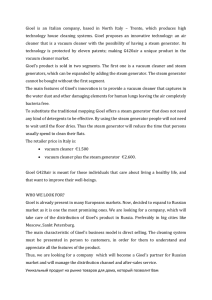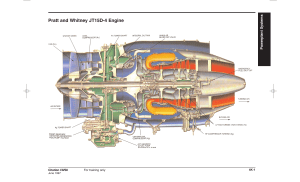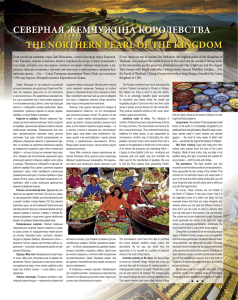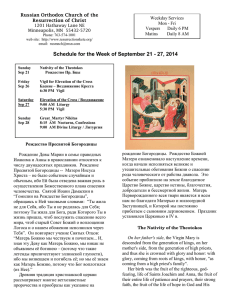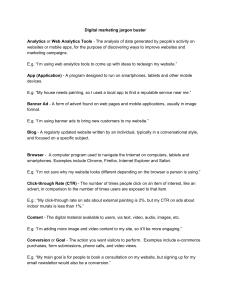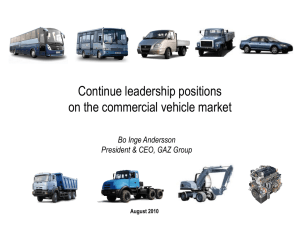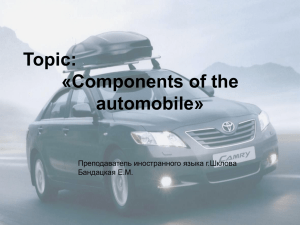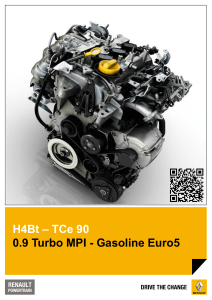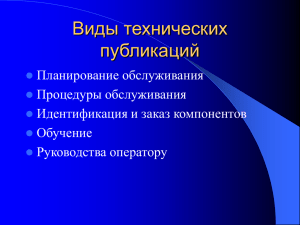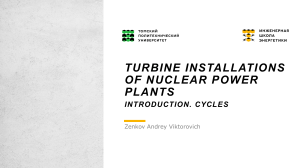АНГЛИЙСКИЙ ЯЗЫК ДЛЯ СПЕЦИАЛЬНОСТИ «АВТОМОБИЛИ И
реклама
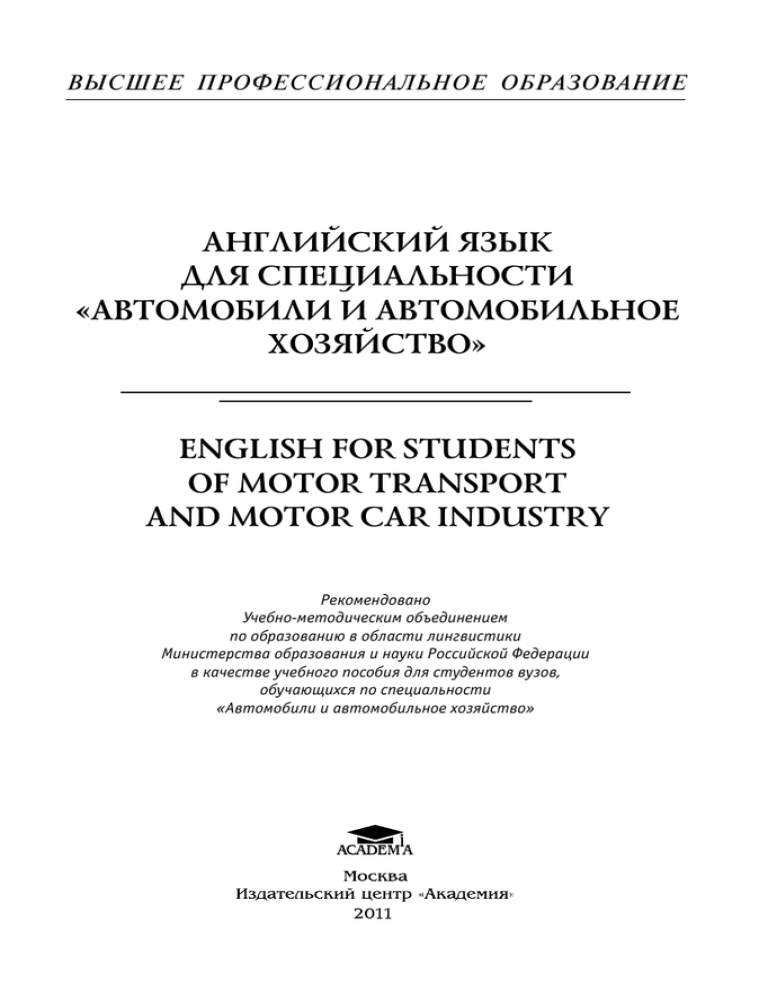
ВЫСШЕЕ ПРОФЕССИОНАЛЬНОЕ ОБРАЗОВАНИЕ АНГЛИЙСКИЙ ЯЗЫК ДЛЯ СПЕЦИАЛЬНОСТИ «АВТОМОБИЛИ И АВТОМОБИЛЬНОЕ ХОЗЯЙСТВО» ENGLISH FOR STUDENTS OF MOTOR TRANSPORT AND MOTOR CAR INDUSTRY Рекомендовано Учебно-методическим объединением по образованию в области лингвистики Министерства образования и науки Российской Федерации в качестве учебного пособия для студентов вузов, обучающихся по специальности «Автомобили и автомобильное хозяйство» УДК 802.0:629.113/.115(075.8) ББК 81.2Англ:39.33я73 А647 А в т о р ы: Г. В. Шевцова — Part I, Texts for Supplementary Reading; В. Е. Сумина — Part II, Glossary; О. Г. Лебедева — Part III, Grammar Review, Texts for Supplementary Reading; С. В. Рождественская — Part IV, Abbreviations List Р е ц е н з е н т ы: кандидат филологических наук, доцент кафедры социально-гуманитарных дисциплин Ставропольского института экономики и управления им. О. В. Казначеева И. И. Лизенко; кандидат технических наук, доцент кафедры технологии машиностроения Южно-Российского государственного технического университета И. Д. Дерлугян Английский язык для специальности «Автомобили и А647 автомобильное хозяйство» = English for students of Motor transport and motor car industry : учеб. пособие для студ. учреждений высш. проф. образования / Г. В. Шевцова, О. Г. Лебедева, В. Е. Сумина, С. В. Рождественская. — М. : Издательский центр «Академия», 2011. — 320 с. ISBN 978-5-7695-6754-4 Пособие написано в соответствии с программой по иностранным языкам для неязыковых вузов. Учебный материал направлен на формирование и развитие языковой коммуникативной компетенции и навыков профессионально ориентированного языкового взаимодействия. Cодержит тексты, заимствованные из оригинальной литературы и охватывающие основные направления данной специальности, разнообразные упражнения, дополнительные тексты для чтения, список сокращений, краткий грамматический справочник и глоссарий. Для студентов 1-го и 2-го курсов учреждений высшего профессионального образования, обучающихся по специальности «Автомобили и автомобильное хозяйство». УДК 802.0:629.113/.115(075.8) ББК 81.2Англ:39.33я73 Оригинал-макет данного издания является собственностью Издательского центра «Академия», и его воспроизведение любым способом без согласия правообладателя запрещается ISBN 978-5-7695-6754-4 © Шевцова Г. В., Лебедева О. Г., Сумина В. Е., Рождественская С. В., 2011 © Образовательно-издательский центр «Академия», 2011 © Оформление. Издательский центр «Академия», 2011 ПРЕДИСЛОВИЕ Настоящее пособие предназначено для студентов 1-го и 2-го курсов технических вузов, обучающихся по специальности «Автомобили и автомобильное хозяйство», владеющих английским языком в объеме программы средней школы. При его составлении авторы руководствовались требованиями ГОС в образовательной области «Иностранный язык» и Программой по иностранным языкам для неязыковых вузов. Пособие рассчитано на 280 часов аудиторных занятий и внеаудиторной самостоятельной работы студентов. Поскольку современный вузовский курс иностранного языка призван носить профессионально ориентированный коммуникативный характер, основной целью данного учебного пособия является обучение студентов чтению, пониманию и переводу научно-технической литературы по специальности, а также развитие навыков устной речи в области профессиональной коммуникации. Как представляется авторам, профориентированность пособия, его тесная связь с профилирующими предметами поможет повысить мотивацию овладения английским языком, позволит студентам расширить свои знания по специальности, а также создаст дополнительные возможности для целенаправленного использования полученных языковых знаний в образовательном процессе и профессиональнотрудовой сфере. С этой целью в пособие включены аутентичные тексты научно-популярного характера, общепрофессиональные и специализированные тексты из английских и американских источников, отобранных по тематическому принципу. Пособие состоит из 4 частей (Parts), содержащих 12 уроков (Units), раздела дополнительных текстов для чтения (Texts for Supplementary Reading), краткого грамматического справочника (Grammar), глоссария (Glossary) и ответов к упражнениям (Keys). Части 1 — 2, тематика которых носит обучающий, развивающий и познавательный характер, рекомендуются для изучения на первом курсе. Части 3 — 4, тематика которых носит общенаучный и специализированный характер, рекомендуются для изучения на втором курсе. Каждый урок начинается с раздела «Активный словарь» (Active Vocabulary), содержащего наиболее употребительную общенаучную, общепрофессиональную и специализированную лексику, овладение которой повышает способность реализации речевого общения в рамках заданной тематики. Предтекстовые упражнения (Pre-Text Exercises), содержащиеся в каждом уроке, включают лексические упражнения на подбор синонимов и антонимов, перевод терминов и словосочетаний, что готовит студентов к самостоятельной работе над текстом, а также упражнения 5 на словообразование (Word-Building), направленные на расширение потенциального словаря. Большое внимание уделено чтению и переводу специальных текстов, предназначенных для работы в аудитории, которые содержат большое количество терминов, используемых в области автомобилестроения. Работа с текстами предполагает развитие четырех видов чтения — изучающего, ознакомительного, поискового и просмотрового, широко представленных в каждом уроке, выбор которых определяется задачей, поставленной при работе с оригинальной литературой: аутентичными общенаучными текстами, материалами по истории автомобилестроения, общепрофессиональными текстами, научно-популярной информацией. Для закрепления навыков устной речи по специальности тексты снабжены системой упражнений: ответы на вопросы, составление вопросов, пересказ текстов, дополнение предложений, реферирование. Послетекстовые упражнения (Text and Vocabulary Exercises) предусматривают закрепление пройденного лексического материала, выработку навыков понимания текста и извлечение нужной информации, а также развитие навыков устной речи. В каждый урок включены тренировочные упражнения по грамматическим темам (Grammar), встречающимся в текстах и вызывающим особые трудности при переводе. В заданиях к упражнениям на перевод или тренировку какой-либо грамматической конструкции не указывается форма их выполнения (устная или письменная), поскольку структура пособия разработана таким образом, что преподаватели могут варьировать формы выполнения упражнений с учетом уровня подготовки студентов. Тексты для дополнительного чтения (Texts for Supplementary Reading) служат для закрепления навыков перевода технической литературы, расширения профессионального кругозора студентов, активного обсуждения изученного материала, а также носят воспитательный характер. Краткий грамматический справочник (Grammar Review) поясняет материал, встречающийся в уроках. Он также содержит сведения о способах словообразования и рекомендации по переводу, реферированию, аннотированию. Предназначается для самостоятельной работы над грамматическими темами, представляющими трудности при переводе. В конце пособия помещен глоссарий (Glossary), объясняющий основные термины, список сокращений, часто употребляемых в технических текстах (Abbreviations List), и ключи-ответы к упражнениям для самоконтроля (Keys). Работа с пособием предполагает аудиторные групповые занятия под руководством преподавателя; обязательную самостоятельную работу студента, выполняемую во внеаудиторное время; индивидуальную самостоятельную работу студента под руководством преподавателя; индивидуальные консультации. Авторы выражают надежду, что данное пособие будет способствовать интересной и творческой работе студентов. PART I HISTORY OF THE AUTOMOBILE UNIT 1 ACTIVE VOCABULARY 1. Read and remember the following words: boiler — котел bore — отверстие to bypass — обходить buggy — легкий экипаж clockwork — заводной механизм cobble — крупная галька, булыжник condensing agent — уменьшающий объем реагент crude — необработанный, грубый development — развитие electric spark ignition — зажигание от электрической искры engine — двигатель flurry — волнение, суета freight — груз gear — привод gunpowder — порох to haul — тащить, тянуть internal combustion engine — двигатель внутреннего сгорания iron rim — железный обод overhead — подвесной piped — соединенный трубами pressure — давление rear wheel — заднее колесо replica — точная копия to show up — показывать spinning wheel — вращающееся колесо, прялка stationary — закрепленный, неподвижный stroke — рабочий ход, такт tiller steering — управление с помощью рукоятки tubular frame — трубчатая рама vehicle — транспортное средство walking beam — поворотный рычаг с возвратно-поступательным движением PRE-TEXT EXERCISES 2. Translate into Russian the following word combinations: A steam powered vehicle, to be not under pressure, to be much more efficient and compact, to be the first of this kind, there is no information about…, to compress the gas, to be limited by…, purpose of the vehicle, to be under pressure, a wind driven vehicles, to be able to separate from, to drive a car, to offer a prize to the winner. 3. Give antonyms to the following words: different last unlimited uncertain weakness low speed to connect unsuitable (for) 7 4. Give synonyms to the following words: alike force effectual to suppose to detach energy huge discovery to topple over bounded vapour suitable (for) WORD-BUILDING 5. Translate the following compound words: Windmill, clockwork, railroad, gunpowder, tramway, waterway, pipeline, railway, highway, airway, airplane, human-powered, skateboard, best-known, household, low-pollution, air-resistance, troubleshooter, air-actuated, air-bag, air-blast, air-break, air-conditioned, air-core, aircushion, air-dried, air-handling, airflow, airframe. 6. Translate the following nouns with the suffixes: -age -al -ance -ant breakage, shortage, storage, bondage, advantage, usage, passage, shrinkage, stoppage, leakage, wreckage, postage; approval, arrival, proposal, refusal, rehearsal; acceptance, accordance, appearance, observance, resistance, performance, maintenance, admittance; applicant, occupant, participant, reactant, assistant, resistant, accelerant. 7. Define to what parts of speech the following words with prefixes refer and translate them: aabadana- amassment, amass, amassable, asymmetry, asymmetrical, acromatism, acromatize, acromatic, adynamia, adynamic; absorption, absorb, absorptive, abnormality, abnormal, abirritant; admeasurement, admeasure, admeasurable, adsorption, adsorb, adsorptive, admixture, admix; anaculture, anacultural, analogy, analogous, anaphase, anaphasic. TEXT WORK 8. Read the text below to learn about the early history of vehicles: Text 1А. What Was the First Car? by William W. Bottorff Several Italians recorded designs for wind driven vehicles. The first was Guido da Vigevano in 1335. It was a windmill type drive to gears and thus to wheels. Vaturio designed a similar vehicle which was also never built. Later Leonardo da Vinci designed a clockwork driven tricycle with tiller steering and a differential mechanism between the rear wheels. 8 A Catholic priest named Father Ferdinand Verbiest has been said to have built a steam powered vehicle for the Chinese Emperor Chien Lung in about 1678. There is no information about the vehicle, only the event. Since Thomas Newcomen built his first steam engine only in 1712, we can guess that this was possibly a model vehicle powered by a mechanism like Hero’s steam engine, a spinning wheel with jets on the periphery. Newcomen’s engine had a cylinder and a piston and was the first of this kind, and it used steam as a condensing agent to form a vacuum and with an overhead walking beam, pull on a rod to lift water. It was an enormous thing and was strictly stationary. The steam was not under pressure, just an open boiler piped to the cylinder. It used the same vacuum principle that Thomas Savery had patented to lift water directly with the vacuum, which would have limited his pump to less than 32 feet of lift. Newcomen’s lift would have only been limited by the length of the rod and the strength of the valve at the bottom. Somehow Newcomen was not able to separate his invention from that of Savery and had to pay for Savery’s rights. In 1765 James Watt developed the first pressurized steam engine which proved to be much more efficient and compact than the Newcomen engine. The first vehicle to move under its own power for which there is a record was designed by Nicholas Joseph Cugnot and constructed by M. Brezin in 1769. A replica of this vehicle is on display at the Conservatoire des Arts et Metiers, in Paris. The Smithsonian Museum in Washington, D. C. also has a large (half size) scale model. A second unit was built in 1770 which weighed 8,000 pounds and had a top speed on 2 miles per hour, and on the cobble stone streets of Paris this was probably as fast as anyone wanted to go it. The early steam powered vehicles were so heavy that they were only practical on a perfectly flat surface as strong as iron. A road thus made out of iron rails became the norm for the next hundred and twenty five years. The vehicles 9 got bigger and heavier and more powerful and as such they were eventually capable of pulling a train of many cars filled with freight and passengers. Many attempts had been made in England by the 1830’s to develop a practical vehicle that didn’t need rails. A series of accidents and propaganda from the established railroads caused a flurry of restrictive legislation to be passed and the development of the automobile bypassed England. Several commercial vehicles were built but they were more like trains without tracks. The development of the internal combustion engine had to wait until fuel was available to combust internally. Gunpowder was tried but didn’t work out. Gunpowder carburetors are still hard to find. The first gas really did use gas. They used coal gas generated by heating coal in a pressure vessel or boiler. A Frenchman named Etienne Lenoir patented the first practical gas engine in Paris in 1860 and drove a car based on the design from Paris to Joinville in 1862. His one-half horse power engine had a bore of 5 inches and a 24 inch stroke. It was big and heavy and turned 100 rpm. Lenoir died in 1900. Lenoir had a separate mechanism to compress the gas before combustion. In 1862, Alphonse Bear de Rochas figured out how to compress the gas in the same cylinder in which it was to burn, which is the way we still do it. This process of bringing the gas into the cylinder, compressing it, combusting the compressed mixture, then exhausting it is known as the Otto cycle, or four cycle engine. Lenoir claimed to have run the car on benzene and his drawings show an electric spark ignition. If so, then his vehicle was the first to run on petroleum based fuel, or petrol, or what we call gas, short for gasoline. Siegfried Marcus, of Mecklenburg, built a car in 1868 and showed one at the Vienna Exhibition in 1873. His later car was called the Strassenwagen had about 3/4 horse power at 500 rpm. It ran on crude wooden wheels with iron rims and stopped by pressing wooden blocks against the iron rims, but it had a clutch, a differential and a magneto ignition. One of the four cars which Marcus built is in the Vienna Technical Museum and can still be driven under its own power. In 1876, Nokolaus Otto patented the Otto cycle engine, de Rochas had neglected to do so, and this later became the basis for Daimler and Benz breaking the Otto patent by claiming prior art from de Rochas. In 1885, in Gottllieb Daimler’s workshop in Bad Cannstatt the wooden motorcycle was built. Daimler’s son Paul rode this motorcycle from Cannstatt to Unterturkheim and back on November 10, 1885. Daimler used a hot tube ignition system to get his engine speed up to 1000 rpm. The previous August, Karl Benz had already driven his light, tubular framed tricycle around the Neckar valley, only 60 miles from where Daimler lived and worked. They never met. Frau Berta Benz took Karl’s car one night and made the first long car trip to see her mother, travelling 62 miles from Mannheim to Pforzheim in 1888. Also in August 1888, William Steinway, owner of Steinway & Sons piano factory, talked to Daimler about US manufacturing right and by September 10 had a deal. By 1891 the Daimler Motor Company, owned by Steinway, was producing petrol engines for tramway cars, carriages, quadracycles, fire engines and boats in a plant in Hartford, CT. Steam cars had been built in America since the Civil War but the early ones were like miniature locomotives. In 1871, Dr. J. W. Carhart, professor of physics at Wisconsin State University, and the J. I. Case Company built a working steam car. It was practical enough to inspire the State of Wisconsin to offer a $10,000 prize to the winner of a 200 mile race in 1878. The 200 mile race had seven entries, of which two showed up for the race. One car was sponsored by the city of Green Bay and the other by the city of Oshkosh. The Green Bay car was the fastest but broke down, and the Oshkosh car finished with an average speed of 6 mph. From this time until the end of the century, nearly every community in America had a mad scientist working on a steam car. Many old news papers tell stories about the trials and failures of these would be inventors. By 1890 Ransom E. Olds had built his second steam powered car. One was sold to a buyer in India, but the ship it was on was lost at sea. Running by February, 1893, and ready for road trials by September, 1893, the car built by Charles and Frank Duryea, brothers, was the first gasoline powered car in America. The first run on public roads was made on September 21, 1893, in Springfield, MA. They had purchased a used horse drawn buggy for $70 and installed a 4HP, single cylinder gasoline engine. The car (buggy) had a friction transmission, spray carburettor and low tension ignition. It must not have run very well because Frank didn’t drive it again until November 10, when it was reported by the Springfield Morning Union newspaper. This car was put into storage in 1894 and stayed there until 1920 when it was rescued by Inglis M. appreciated and presented to the United States National Museum. 11 TEXT AND VOCABULARY EXERCISES 9. Choose the right word and fill in the gaps. 1. Vaturio … a similar vehicle which was also never built. a) designed b) proposed c) applied 2. Newcomen’s … had a cylinder and a piston and was the first of this kind. a) carburetor b) engine c) muffler 3. The first vehicle … under its own power for which there is a record was designed by Nicholas Joseph Cugnot. a) to move b) to fly c) to navigate 4. The early … powered vehicles were so heavy that they were only practical on a perfectly flat surface as strong as iron. a) gas b) petroleum c) steam 5. Many attempts had been made in England by the 1830’s to develop a practical vehicle that didn’t need … . a) rails b) road c) highway 6. The development of the internal combustion engine had to wait until fuel was available … internally. a) to evaporate b) to combust c) to vaporize 7. … cars had been built in America since the Civil War. a) gas b) steam c) petroleum 10. Find in the text equivalents to the following phrases: Управляемые ветром транспортные средства, сила клапана, пар под давлением, длина рычага, был разработан, высшая скорость, транспортные средства стали больше и тяжелее, делать много попыток, газовый двигатель, двигатель внутреннего сгорания, деревянные колеса, бензиновый двигатель. 11. Find the English equivalents to the following Russian words: 1) проект 2) колесо 3) транспортное средство 4) двигатель 5) тяжелый 6) мощный 7) ограничительный 8) развитие 9) сгорать 10) поездка 11) вдохновить 12) с тех пор 12 a) design a) while a) vehicle b) decision b) wheel b) vehicular c) designation c) wheal c) velocimeter a) a) a) a) a) a) a) a) a) b) b) b) b) b) b) b) b) b) c) c) c) c) c) c) c) c) c) engineer heavy powering descriptive devotion to combust strip to impress science engineering have powerful restocking description to combine trip to inspire since engine heave powerless restrictive development to coincide track to imprint sincere 12. Work in pairs, think of some questions to review the contents of the text and ask each other. Use the word combinations below: a steam powered vehicle the first vehicle to move under its own power a road made out of iron rails the first gas engine combusting the compressed mixture steam powered car first steam engine the development of the internal combustion engine a top speed one-half horse power engine wooden wheels single cylinder gasoline engine 13. Divide text 1A into logical parts and give each a suitable title. 14. Fill in the gaps with the words from the box: is derived include terms transportation vehicle driver An automobile is a wheeled 1)___ that carries its own motor. Different types of automobiles 2) ___ cars, buses, trucks, vans, and motorcycles, with cars being the most popular. The term 3) ___ from Greek ‘autos’ (self) and Latin ‘movére’ (move), referring to the fact that it ‘moves by itself’. Earlier 4) ___ terms for automobile include ‘horseless carriage’ and ‘motor car’. An automobile has seats for the 5) ___ driver and, almost without exception, one or more passengers. It is the main source of 6) ___ across the world. Check your answers on p. 321 TEXT WORK 15. Read and translate the text. Text 1B. The First Automobile Companies Henry Ford had an engine running by 1893 but it was 1896 before he built his first car. By the end of the year Ford had sold his first car, which he called a Quadracycle, for $200 and used the money to build another one. With the financial backing of the Mayor of Detroit, William C. Maybury and other wealthy Detroiters, Ford formed the Detroit Automobile Company in 1899. A few prototypes were built but no production cars were ever made by this company. It was dissolved in January 1901. Ford would not offer a car for sale until 1903. The first closed circuit automobile race held at Narragansett Park, Rhode Island, in September 1896. All cars were Duryeas and a Morris & Salom Electrobat. Thirteen Duryeas of the same design were produced at the factory in 1896, making it the first production car. In 1898, the broth- 13 ers Duryea, the owners of the factory, went their separate ways and the Duryea Motor Wagon Company was closed. Charles, who was born in 1861 and was eight years older than Frank, had taken advantage of Frank in publicity and patents. Frank went out on his own and eventually joined with Stevens Arms and Tool Company to form the Stevens—Duryea Company which was sold to Westinghouse in 1915. Charles tried to produce some of his own hare-brained ideas with various companies until 1916. Thereafter, he limited himself to writing technical book and articles. He died in 1938. Frank got a half a million dollars for the Westinghouse deal and lived in comfort until his death in 1967, just seven months from his 98th birthday. In 1899, production of the Olds Motor Vehicle Company of Detroit began. After an early failure with luxury vehicles they established the first really successful production with the classic Curved Dash Oldsmobile. The Curved Dash Oldsmobile had a single cylinder engine, tiller steering and chain drive. It sold for $650. In 1901, 600 were sold and the next years were 1902 — 2,500, 1903 — 4,000, 1904 — 5,000. In August 1904, Ransom Olds left the company to form Reo (for Ransom Eli Olds). Ransom E. Olds was the first mass producer of gasoline powered automobiles in the United States, even though Duryea was the first auto manufacturer with their 13 cars. Ransom Olds produced a small number of electric cars around the turn of the century. Little is known about them and none survive. In 1899 and 1900, electrics outsold all other type of cars and the most popular electric was the Columbia built by Colonel Albert Augustus Pope, owner of American Bicycle Company. Lutzmann of 1895 by J. A. Koosen and H. Lawson is typical of American design in the mid 1890’s. It was truly a horseless carriage. Tiller steering, engine under the floorboards, very high center of gravity, not 14 designed for road travel. Imagine climbing into one of these and trying to drive across town and around a few corners. This Daimler of 1899 was owned by Lionel Rothchild. The European design is much advanced of the American designs of the same time. Gottlieb Daimler took part in the London-to-Brighton run in 1896 but died in 1900 at the age of 66 without ever meeting Benz. His German engines powered the automobile industries of Britain and France. The 1908 Haynes in the back ground shows the rapid development of the petrol powered car when compared to the 1894 model in the foreground. The Rolls Royce Silver Ghost of 1906 was a six cylinder car that stayed in production until 1925. It represented the best engineering and technology available at the time and these cars still run smoothly and silently today. This period marked the end of the beginning of the automobile. Notes on the text hare-brained ideas — легкомысленные идеи financial backing — финансовая поддержка TEXT AND VOCABULARY EXERCISES 16. Translate into Russian the following words and word combinations: Prototype, production cars, of the same design, a single cylinder engine, tiller steering, chain drive, the first mass producer, gasoline powered automobiles, auto manufacturer, electric cars, a horseless carriage, center of gravity, road travel, rapid development, a six cylinder car, to represent the best engineering and technology. 15 17. Find in the text the English equivalents to the following Russian words: строить развитие преимущество изготовитель типичный создавать; организовывать поддержка производство производитель выжить действительно представлять богатый гонка бензин тип, модель быстрый начало 18. Compose your own sentences with each English equivalent of the words given in exercise 17. Compare your variants with the sentences of your partner. 19. Work in pairs and decide whether these statements according to text 1B are true or false: 1. Ford had sold his first car, which he called a Quadracycle, to build another one. 2. Without any financial backing of wealthy people Ford formed the Detroit Automobile Company in 1899. 3. Ransom E. Olds was the first mass producer of gasoline powered automobiles in the United States. 4. By the end of the century Ransom Olds had produced a great number of electric cars. 5. Lutzmann of 1895 was an automobile of typically European design. 6. The European design was much advanced of the American designs of the same time. 7. The Rolls Royce Silver Ghost of 1906 was a single cylinder car that stayed in production until 1925. 8. The Rolls Royce Silver Ghost represented the best engineering and technology available at the time. 20. Translate the following sentences into English using a dictionary: 1. История автомобильной промышленности насчитывает более чем 100 лет. 2. Автомобильная промышленность часто расценивается как главный двигатель индустриального роста двадцатого столетия. 3. Методы производства автомобилей, от их кустарного изготовления до массового производства, всегда имели большое влияние на организацию и технологию других отраслей промышленности. 4. Современные автомобили состоят из более 1 200 деталей. 5. Автомобильная промышленность является важным и динамичным сектором промышленности практически любой экономически развитой страны. 6. Использование автомобилей привносит комфорт, скорость и удобство в современную жизнь человека. 7. Огромный рост количества транспортных средств приводит к загрязнению окружающей среды. 8. Современная стратегия автомобильной промышленности состоит в том, чтобы сделать транспортные средства более эффективными и экологически безопасными. 16
